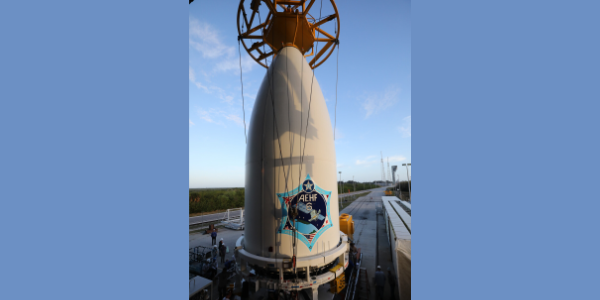Space Force Looks to Next Generation of Data Management
Unlike the other services, the military’s newest service, the U.S. Space Force, is starting with a chief data officer in place on day one of its existence. With an executive in place to guide how the service will administer its information, and with support from its top leadership, the service aims to have its data aid its strategic advantage.
“The Space Force is adopting what we call next-generation data management,” explains Mark Brady, chief data officer, U.S. Space Force. “The basic idea is that we’re treating it as a very precise engineering discipline as opposed to being informal, or a little bit loose with our definitions or methods. What we found is that in order to address changes in data and the changes in volume and in complexity of our information, we need enterprise data management.”
Brady, a retired sergeant in the Marines with stints as a data architect for the Department of Justice and information architect for the National Marine Fisheries Service as well as a doctorate degree in neuroscience, started with the U.S. Air Force a year ago. “In the olden days we knew where our data was. It was right over there in the filing cabinet,” he states. “And now we have petabytes of data, maybe even exabytes of data, and we have thousands of data sets. So, simple things like even knowing what data you have, what it means, how to access it, things like that you can’t take for granted.”
Before the Space Force was established in December, Brady, along with Maj. Gen. Kimberly Crider, USAF, mobilization assistant to the Chief of Space Operations, United States Space Force—who had served as the Air Force’s first chief data officer—hosted the Air Force Space Command data management innovation summit last summer to create a data management strategy road map. More than 100 people attended the event, giving the leaders a sense of what worked as far as information management, Brady says.
With that feedback, they created the first-of-its-kind enterprise data management strategy for the Air Force Space Command. Since then, Brady has replicated and tailored that effort to suit the Space Force, creating the service’s first next-generation data management strategy. The plan was recently approved by Gen. John W. “Jay” Raymond, USAF, chief of Space Operations, U.S. Space Force, and commander, U.S. Space Command. It’s been a seamless process transitioning from the Air Force, Brady says.
“There’s a lot of continuity going from Air Force Space Command to Space Force,” he shares. “And we’re working closely with the CDO [chief data officer] of the Air Force and the Air Force in general. We are looking at not only making the data discoverable and understood, and integrated and accessible, but we’re also looking at the data being faster and more accurate.” He adds that the Space Force will continue to work closely with the Air Force and the National Reconnaissance Office, especially as far as data needs regarding satellite communications. “Satellites transmit and collect a lot of data, so we’re very datacentric in that regard,” he notes.
The Space Force’s strategy is a comprehensive administration of its data across sources, functions, users, storage and analysis, to decision making. It builds on previous methods, provides uniform terminology and a coherent platform, the chief data officer states. “Previously, data was not even attended to at all,” he says. “[It] was treated in some sort of ad hoc and informal manner and it wasn’t sufficient. We had bad models of how we were supposed to manage things. We were sloppy with our terminology. And there was talk about the data life cycle and then it turned out that we weren’t managing data in the life cycle at all. These are some of the struggles in the early days of data management. So that’s why what we’re doing here in the Space Force is adopting a next generation approach to data management.”
They began by examining the uses of Space Force data, then modeling the data user. The service is using a number of models, including a system to catalog all the data, the data sets and the databases, which will allow users to search for different kinds of information. Other models will help users comprehend all of the possible types of information. “There’s the matter of understanding the data,” he adds. “So, you have these very complex data sets that might have dozens of tables in them. How do you understand how to use that information? What’s the relationship between all the different parts within that database? And so, for that, we have methodologies and data dictionaries that we use so that the users, whether they’re programmers or analysts, can understand that data.”
The chief data officer also is looking at integration and the sound design of data systems. “With next generation data management, one of our best practices, and we have a whole collection of best practices, but one of the most important I would say is integration,” he states. “What we would like to do as we start to modernize our systems is to design them as a single super system so that they’re optimized. And we’re looking at not only making the data discoverable and understood and integrated and accessible, but we’re also looking at the data being faster, more accurate, the data systems being more efficient and so all of that comes out of system design, which we’re very much interested in.”
In tackling how effectively to deliver access to data, the Space Force is trying to get away from the idea of data owners and using an ad hoc access system. “In the new approach, we think of data stewards,” he emphasizes. “Individuals and units, they don’t own the data. The Space Force owns the data. And before, if you knew the person who had that data, and you gained their trust, they might allow you to see that data. But we want to have more of a comprehensive uniform approach to access, so that if you have the right clearance, if you have a mission need, then it should be a very streamlined process for you to get that data. We’ll be able to support the mission much better because of that.”
Additionally, the service has set up a data governance council to help guide its information management. A charter for the council has been signed and the membership formed. Their first meeting was slated to be held mid-April. The council includes representatives from the Space Force’s major commands: Systems Command, which develops new platforms; Operations Command, which manages the military operations; and Star Command, which is responsible for providing training and resources to warfighters.
While the Space Force is playing a unique role in space-based warfare, the call for multidomain operations and Joint All-Domain Command and Control across the U.S. military is prompting more of an interoperable approach, which applies to data management, the chief data officer notes. He is also looking forward to working with the chief data officers of the Army, Navy and the Marine Corps.
“We have a new perspective, which is multidomain warfare,” Brady states. “We don’t just think about a war in space or in the air or on land or at sea. We think about a number of these domains combined together in any conflict, and that’s the way that it’s going to be going forward. So, we’re looking at how our role as a service can bring things to bear within joint, multidomain, all-domain warfare.”
As for challenges, the chief data officer identified the need to shift expectations and practices. “I would say that one of the challenges that most organizations meet, and we will meet this to some extent, is cultural change,” Brady notes. “We have to start thinking not so much about how tightly we hold that data, although we do want it to be secure, and we don’t want unauthorized individuals to gain access to that data. But now we want to reverse the measure to some extent. We want to measure how effectively a person is doing their job by how much they’re getting their data out there and sharing it with other people who are pursuing the same mission.”
Regarding how the industry could assist the Space Force in its data management efforts, Brady suggests that it may not be only about better data analytics or artificial intelligence (AI). “If you think about the whole data flow process, that is something that comes at the end,” he explains. “There’s a lot of enthusiasm, which is a good thing in the area of AI, but that also depends on the preliminaries. So, it’s really those capabilities that we think are the crux of the matter. How do you make that data more interoperable, discoverable, understood, integrated, and accessible and so forth?”
Bringing about a new paradigm for data management in the Space Force will take some effort, he acknowledges, as it is especially important to take the time to set the foundation for how the service will manage its information. “It’s not going to be done this year,” he states. “It’s going to be done over the next few years. We will be implementing the strategy into the foreseeable future.”
“Whether or not you win or lose, depends on whether you have a winning strategy, and whether you have a winning strategy depends primarily on two things,” Brady advises. “And that is what you have and what you know. What you have is your physical assets, including your personnel, and what you know is your data. And when you think about some historical examples, for instance, with Midway, why was it the turning point in the Pacific in World War II? It was because we had the intel, which is another kind of data. The role of the Space Force’s chief data officer is to not only ensure that we have the data, but that the data is organized in such a fashion that it will be a strategic advantage for us.”






Comments